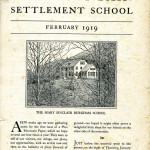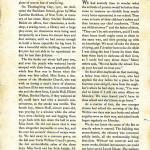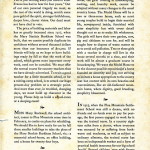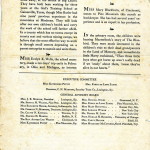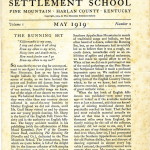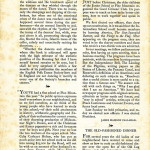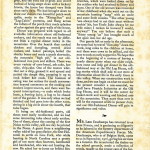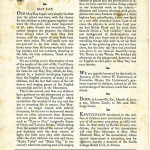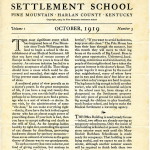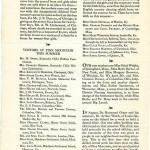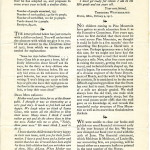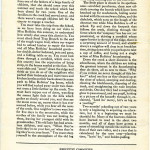Pine Mountain Settlement School
Series 17: PMSS Publications (Published by the School)
NOTES – 1919
“Notes from the Pine Mountain Settlement School”
February (Inaugural Issue), May and October 1919
GALLERY: NOTES – 1919 February
- NOTES – 1919 February, page 1. [PMSS_notes_1919_001.jpg]
- NOTES – 1919 February, page 2. [PMSS_notes_1919_002.jpg]
- NOTES – 1919 February, page 3. [PMSS_notes_1919_003.jpg]
- NOTES – 1919 February, page 4. [PMSS_notes_1919_004.jpg]
CONTENTS
NOTES – 1919 FEBRUARY: Kentucky schools ; Burkham School fire ; fires ; deaths ; rebuilding ; sicknesses ; Mary Sinclair Burkham ; Edith Scott ; Caroline Burkham ; Landis Hall ; Elbert Walker ; Birchel Harris ; Almon Huff ; William Creech ; Mary Rockwell ; Harriet Butler ; Dr, Grace Huse ; Evelyn K. Wells ; Mary Blackburn ; Executive Committee ; General Advisory Board ; drawing ;
We thought in the first days following [the Burkham School fire] we could not go on with the [“Notes”]. ..But it seems the best way to let you know of our losses and our grief, of the staunch upholding of parents, and of our plans for months ahead. After all, it can bring you word not alone of sorrow but of new living.
TRANSCRIPTIONS:
FEBRUARY 1919
P. 1
A few weeks ago, we were gathering notes for the first issue of a Pine Mountain Paper, which we hope to send out four times a year. They were to tell of our visitors, our doings, our plans, our opportunities, With an article now and then on the balladry or plays [dances] of the mountains, or on some interesting bit of local history; notes written to record the life of the school and to suggest its background — We hoped it might often approve a delightful little sheet for our friends on the other side of the mountain.
Just before the material went to the printer, on the night of Thursday, January twenty – third, the Mary Sinclair Burkham School was burned. Miss Edith Scott, the book – keeper, and four boys died in the fire.
P. 2
We thought, in the first days following, we could not go on with the paper whose 1st number might bring you such tragic news. But it seems the best way to let you know of our losses. And our grief, of the staunch upholding of parents and of our plans for months ahead. after. all, it can bring you word, not alone, of sorrow. But of new living.
On Thanksgiving Day, 1917, We dedicated the Burkham School, given by Miss Caroline Burkham of, of New York in memory of her sister, Mary Sinclair Burkham. Besides six offices, 4 classrooms, a workshop, a sewing room, a library, and a large playroom, 6 classrooms were being used temporarily as a home for 16 boys and four workers, until we had money enough to build a home, especially for big boys. It was a beautiful white building, insured for 10,000 but not able to be reproduced today for less than $18,000.
The fire broke out about 2:30, And even the people who wakened barely escaped with their lives, as practically, the whole first floor was in flames. When the alarm was first called. Miss Scott, a deaconess of the Methodist Church, who was with us during a year’s leave of absence, had been ill for two weeks.. It is certain that she and the three boys, Landis Hall, Elbert Walker, Birche Harris, if they awakened at all, could have had only a second of consciousness as the smoke was terrific. The 4th boy, Almon Huff, 16 years old, was praying by a window while the other boys were climbing out and begging them to go back with him down the hall to save Miss Scott.. He did not know that it was then altogether impossible to save her and his own few seconds. Chance of escape went by.. We laid away in a common grave on the. hill near Uncle William Creech’s grave, The few unidentifiable ashes of the three boys. Miss Scott, in her little knight, almond, lies side by side. As we knelt in the warm sunshine that Saturday afternoon, Some sense of peace came to us from the knowledge that we could always associate with their graves, not the fright and horror of the fire, but the nobility of a boy’s dying thought in a moment of utter peril.
We had scarcely time to wonder what the attitude of parents would be before they came to reassure us.— Kin folk from nearly every home represented in our school. They came to learn of their children’s safety, and they became our chief comforters..”Take my children away?” said the father of three “They Can’t be safe anywhere if. I took them home. Death might come to them in the same way, and they growing up with no knowledge. We must all take the chance of dying, and I’d rather have mine die while I was doing the best I know for them. Then keep them back in darkness all their lives, so I could feel easy about them. “Many, ” Others said, No one faults the school.” You do your best, and we trust you.”
An hour after daybreak on that morning, a father from 30 miles away, who had applied the day before for a place for his 14 – year -” Old ha girl, came from the neighbors where he had slipped, to say, I’m worried to know if I still can enter Allen. On Monday.. We were feared you’d have to close school, and she’d have to go home.”
As a matter of fact., the two younger classes had schooled the morning of the fire. Within two days, new text – books and school supplies were on their way, and school work began regularly on Monday.
We do not know the cause of the fire, or exactly where it started. The building was steam – heated, The chimney was cemented solidly inside, All the workmanship being first – class. without our reservoir and our water works, Finished last summer, we could not have saved Laurel House. the workers and children showed remarkable calmness and presence of mind, and there was no hysteria…
P. 3
...hysteria Before a fire so fierce that it consumed the whole building in three – quarters of an hour.
Courage must be our word.: ” A 14 – year – old girl looking mournfully into the ruins, said, of course we can stand it..” This is just nothing when you think of what France has had to bear for 4 years.” Out of our own personal tragedy, we must, as the rest of the world is doing, **** some pure gold of the spirit, stronger faithfulness, deeper love, clearer vision. Our dad must not have died in vain.
The price of building materials and labor has so greatly increased. Since 1917, when the Mary Sinclair Burkham School was built, that we cannot possibly duplicate its usefulness without several thousand dollars more than our insurance of $10,000. If friends will help us, we hope to have buildings ready by fall, so that the work of the school, which grows more important every week, need not be curtailed. We must offer the normal course for country teachers that we have already advertised. To train a good teacher for a little mountain school, or for a mining – camp school, to. attack our huge present – day problem at a strategic point.. And more than ever, in troubled, changing days, we must build up character in the young. Please help us build a school – room, or a sleeping room!
Miss Mary Rockwell [Hook], This school architect, comes to Pine Mountains sometime in February, to confer on plans for rebuilding. We should like to have ready for use by fall. 3 smaller buildings to take the place of the Mary Sinclair Burkham School,viz.: A memorial school – house, and office building, and a house for twenty – four boys.
The Southern Industrial Education Association has given $1,250.00 For a model home where girls may practice living under conditions, they are likely to meet in their own homes. Although the Pine Mountain ideal has always been to house the scholars in cottages, so that the atmosphere may be home – like in not institutional, the girls’ training and housekeeping, cooking, and laundry work, cannot be adapted without many changes to the usual country home. The model home will be a two or three – room house, such as most young couples build to begin their married life, newspapered inside, furnished with utter simplicity, but with every detail thought out so as to make life wholesome. The girls will have their own garden, cow, pig and chickens to care for, and will be taught how to dispose of waste matter so as to avoid soil pollution. 2 or three girls with a teacher in charge will live in the house several months at a time, and their work will be almost a graduate course. In housekeeping. we want the model home. To be the clearest possible exposition of a home founded on sincerity and joy, not striving to imitate a house appropriate to the county seat, but content with its own beauties and conveniences, Like an old fashioned mountain home, where dignity, good breeding, simplicity blossomed.
In 1913 when the Pine Mountain Settlement School was still a dream, with no friends and no funds even to pay for postage. The first person engaged to work for it was the trained nurse. In a country 18 miles from a doctor, where everyone was menaced by or suffering from hookworm and trachoma, as well as subject to ordinary ailments, the trained nurse has been an indispensable worker. In a form of practical health insurance for our big school family. burned children, men with fingers chopped off. New babies, ailing babies, a smallpox epidemic, Hookworm and trachoma….
P. 4
… trachoma clinics, measles, whooping cough, these have been the nurse’s opportunities in the last six years. Yet the needs for many miles around are untouched. In May, Dr Grace Hughes and Miss Harriet Butler came to establish a medical settlement, four miles away, at the mouth of Big Laurel. they have both been working for three years at the girl’s training school. At Gainesville, Texas, though Miss Butler had nine years previous experience in the mountains at Heineman. they will look after our own children’s health. And carry the work of the school still farther afield. In a county which has no towns except its county seat and various mining camps, we believe that the most effective way to work is through small centers, depending on apparent enterprise to sustain and unite them.
Miss Evelyn K. Wells, the school secretary, made a 10 day trip in February, in Ohio and Michigan, to interest friends in our medical settlement. In Akron, she spoke on the history of mountain music, whose beauty is today, widely appreciated through the work of such musicians as Miss Loraine Wyman, Mr Howard Brockaway, [and] Mr. Cecil Sharp.
Miss Mary Blackburn of Cincinnati comes to Pine Mountain this month. As bookkeeper. she has had several years experience and is an expert in her profession.
” In the primary room, the children were hearing Maeterlinck’s story of the Bluebird. They were much interested in the children’s visit to their dead grandparents in the land of memory, and immediately little Harry exclaimed, “Then those little boys, what got burnt up aren’t really dead if we study about them ’cause they’re alive in our hearts.”
GALLERY: NOTES – 1919 May
- NOTES – 1919 May, page 1. [PMSS_notes_1919_may_0011.jpg]
- NOTES – 1919 May, page 1. [PMSS_notes_1919_may_0021.jpg]
- NOTES – 1919 May, page 3. [PMSS_notes_1919_may_0031.jpg]
- NOTES – 1919 May, page 4. [PMSS_notes_1919_may_0041.jpg]
CONTENTS
NOTES – 1919 MAY: Kentucky Running Set ; lyrics ; Loraine Wyman ; Howard Brockway ; Cecil Sharp ; dances ; singing ; clubs ; dinners ; May Day ; deaths ; births ; Maud Karpeles ; Leon Deschamps ; Celia Cathcart Holton ; Virginia Whitmore ; Arthur W. Underwood ; Alberto Zande ; Mr. Luigi Zande ; Mrs. Luigi Zande ; Elizabeth Bliss ; Executive Committee
Mrs. [Celia Cathcart] Holton and Miss [Virginia] Whitmore leave golden opinions behind them.
TRANSCRIPTION:
May 1919 Vol. 1 No. 2
THE RUNNING SET
“Killiecrankie is my song,
I sing and dance it all along
From my elbow to my wrist,
Heavy turn and double twist,
How much furder can I go
From my elbow to my toe?”
So runs the rhyme we sing for accompaniment to one figure in our plays (dances) at Pine Mountain. Just as we have been taught ballads by children hailing from scores of creeks, So we have learned the gayest and liveliest old dances from various parts of the mountains. The pedigree of our ancient, beautiful songs we knew, But of the origin of our dances, we were not sure. We believe them to be old, but that they were older than any country dances collected in out-of-the-way Hamlets in Mother England. We did not dream, until Mr Cecil Sharp visited us. And by chance, saw our young people dancing.. Mr Sharp is the head of the English folk dance society. And is the authority on English lore. (The happy accident resulted in his publishing.) With the collaboration of Miss Maude Karpeles), Part V of the Country Dance Book, containing The Running Set (Novello and Co.), dedicated to the Pine Mountain School. The introduction, from which we quote below, is full of the delight felt by the famous collector of folk – simples in discovering not only a more ancient dance than any he had known. but one of great beauty:
“In the course of our travels in the Southern Appalachian Mountains in search of traditional songs and ballads, we had often heard of a dance, called the running set, but, as our information had invariably led us to believe that it was a rough, uncouth dance, remarkable only as an exhibition of agility and physical endurance., We had made no special effort to see it. when. at last we did see it performed at one of the social gatherings at the Pine Mountain Settlement School. It made a profound impression upon us. We realized at once that we had stumbled upon a most interesting form of the English country dance, which, so far as we knew had not been hitherto recorded. , and a dance, moreover, of great aesthetic value. . ,
“When the last book of English folk dances was published — now some years ago — It looked as if the available material were at last exhausted, and that our knowledge of existing traditional dances had practically reached its limit. That further and most valuable material actually existed at that time in a country several thousand miles away from England patiently waiting for the call of the collector, certainly did not occur to me, nor, I am sure, to any of my friends or collaborators. And even when, later on, I had penetrated into the southern Appalachians and found the old Puritan dislike, fear and distrust of dancing. expressed in almost every log cabin I entered., the possibility seemed more remote than ever, my surprise, then, can be imagined when, without warning, the Running Set was presented to me under conditions, too, which immensely heightened …
P 2.
…heightened its effect. It was danced, one evening after dark, on the porch of one of the largest buildings of the Pine Mountain School, with only one dim lantern to light up the scene. But the moon streamed fitfully in., lighting up the mountain peaks in the background, and, casting its mysterious light over the proceedings, seemed to exaggerate the wildness and the breakneck speed of the dancers as they whirled through the mazes of the dance. There was. no music, only the stamping and clapping of the onlookers, but when one of the emotional crises of the dance was reached,—- and this happened several times during the performance — “the air seemed literally to pulsate with the rhythm of the “patters” and the tramp of the dancers feet, while, over and above it all, penetrating through the den, floated the even, falsetto tones of the callar, calmly and unexcitedly reciting his directions. . .
” Whether the dancers and others to whom this book is addressed will agree with the high estimate of the esthetic qualities of the running set that I have myself formed. Remains to be seen, but I shall be very surprised if, within a few months of its publication, the members of the English Folk Dance Society here and in England are not dancing it merrily in every one of the Society’s branches and centers.”
“You’ve .” Had a fine school at Pine Mountain this year. So public opinion expresses itself everywhere in our neighborhood, and so we feel ourselves, as we think of the young people who have learned to study in this school, — of — Their solid attainments in history, arithmetic, geography, and English, of their enthusiasm for current events, of their charming production of Midsummer Knight’s dream, And of the Christmas and Easter pageants —a rich and fortunate year for boys and girls. Next year, we lose the two teachers of the upper school. Mrs Celia Cathcart Holton, who has put as much ardor into her schoolwork as she did into raising 25. thousand dollars. For the road, will not be with us on account of her husband’s return from France, while. Miss Virginia Whitmore spins next year in further study.. the response of the children in Miss Whitmore’s classes is their unconscious Comment on her exceptional power in conducting recitations. Miss Holton and Miss Whitmore leave Golden opinions behind them.
THE GOOD CITIZENS CLUB
Just before Christmas, the older children of the junior school at Pine Mountain organized the Good Citizens Club. Its purpose was to teach us how to be better citizens, how to work together and speak in public.
We first elected our officers, then drew up our constitution; In it, we said that the intermediate school could become members by learning, America, The Star Spangled Banner, and the Pledge to the Flag. After appearing on the program once, they are voted in by the charter members and those who receive a two – thirds vote are admitted.
In our meetings, we follow parliamentary rules, first having an open meeting, then a business meeting. The programs have been patriotic, with the members learning poems like the independence bell, the landing of the pilgrims, writing papers on the statue of Liberty, the Panama Canal, and Roosevelt’s definition of an American; And debating on such subjects as,”” resolved.. that a useful citizen is more useful to a nation than a famous one.” We enter role – call.” with such things as,.” Why I am glad that I am an American.” We have had newspaper programs with original cartoons, editorials on better roads and fences,” and stay in school.” articles, write – ups of the Peace Conference and Current Events, and funny local news.
Last Sunday, we held primaries, And today we elected new officers. I was elected president.
JAMES MADISON CALLAHAN
[See the following]
GALLERY: NOTES – 1919 October
- NOTES – 1919 Oct, page 1. [PMSS_notes_1919_oct_001.jpg]
- NOTES – 1919 Oct, page 2. [PMSS_notes_1919_oct_002.jpg]
- NOTES – 1919 Oct, page 3. [PMSS_notes_1919_oct_003.jpg
- NOTES – 1919 Oct, page 4. [PMSS_notes_1919_oct_004.jpg]
CONTENTS Vol. 1 No. 3
NOTES – 1919 OCTOBER: Medical Settlement ; Pole House ; playground ; Office Building ; fieldstone ; J.S. Duncan ; A.W. Underwood ; gifts ; visitors list ; volunteers ; teachers ; Ethel Wright ; Ruth Barber ; Margery Brewster ; Clarence Dorsay ; Esther Sandstrom ; Miss Butler ; Dr. Huse ; dental clinic ; Dr. Raymond Grant ; Dr. Arthur Welch ; letters ; Theodore Westergaard ; road construction ; Meldrum & Meldrum ; fiscal year ; Lilliath Robbins ;
We shall always love the old trail, one mule wide and twenty-per-cent grade; but the new road passes under cliffs that the trail gave us no knowledge of, and reveals the wonderful rocky structure of Pine Mountain as well as its marvelous rhododendron thickets.
P. 1
The most. significant event which has happened here at Pine Mountain since Uncle William gave his land to begin a school is the establishment of our medical settlement.. All that you have read of remote corners of Europe in the last few years is true of this country. an extreme isolation has led. To a fatalistic acceptance of all ills. That thing should have a cause which could be discovered and remedied, that right ways of living prevent most diseases, are unheard of ideas.
A medieval point of view prevails as to a doctor’s power. In the great emergencies of life, you have a nag and twenty – five dollars to pay, you can ride a day and perhaps be so fortunate as to find a personage who is a sort of wizard – a doctor. In one visit by the administration of some. quote, Vile dose, in quote, he can make everything right.- that is, if you have the luck to find a good doctor who has an almost magic power of prescribing doses. If your luck is bad, then you have to accept suffering and death, as the will of God. As for keeping babies healthy by right diet, controlling the spread of eye disease by cleanliness, preventing hookworm disease by sanitary measures — these are as unheard-of notions as the germ theory of disease was to our grandparents.
Such a country has come a doctor, not fond of giving medicines, but anxious to be established ways of help, and a nurse whose passion is to teach.. Over and over, they must Iterate such facts as,” If you want your baby to live through its first year, don’t feed it green apples and blackberries.” ; ” If you want to avoid hookworm, keep your skin clean.” The pole house has been their base through the summer, But this month, they will move to their log house at the mouth of Big Laurel. here. is their great. Opportunity. un., hardworking, contentious and kind hearted, The people of that neighborhood have taken the greatest interest in the Doctor’s house. The people’s logs for it were given by the men of that neighborhood, many of whom have put in two and three days free labor at a time when a day’s wages are hard to spare. The log house is big enough to hold another worker, who will teach industrial subjects in the school near by, have charge of a playground on the Settlement property. (The only piece of ground for miles around, big enough for children to play baseball), teach Sunday school, and help to make the Medical Settlement a levening agency.
NEW BUILDINGS
The Office Building is nearly ready for use — indeed, two offices are already serving as temporary schoolroom. Only the inside of this building is finished at present; the fieldstone exterior must wait until the Mary Sinclair Burkham School House is made ready for occupancy.. that build that building. That building is now being roofed, and we expect to use it this winter, although another summer season will be required to finish both these two new buildings.
It seems that we have never had to turn away so many boys and girls as have been refused places this summer. People have heard of our “good school.” Visiting parents ……
P. 2
….. parents who have wanted their children to “be raised up plum above where they were” have Been impressed by our children’s housekeeping, their table manners, and by their health. nothing is so hard for the Executive Committee as to see tears come into the eyes of boys and girls when they are told there is no place for them — And sometimes the mothers come in week two with disappointed children! Next summer cannot be quite so hard as this has been, for Mr J. S. Duncan, of Chicago, is giving us the money for a house for twenty-four boys. Mr. A.W. Underwood, of Chicago, whose death we recorded in our last issue, has left us with a bequest of $1,000, which we hope to use as a nucleus of a fund for a house for twenty-four girls. [Far House]
*****
VISITORS AT PINE MOUNTAIN THIS SUMMER
Mr. W. Swift, Kentucky Child Welfare Commission.
Mr. Charles Gibbons, Kentucky Child Welfare Commission.
Mrs. Kennicutt Breton, Cincinnati Ohio.
Miss Anni Clark, Fort Wayne, Ind.
Miss V.W, Buffum, Lincoln Memorial University, Harrogate, Tenn.
Mrs. George DeLong, Norwich, Conn.
Miss Helen DeLong, Norwich , Conn.
Mr. J.M. Trosper, Evarts, Ky.
Miss Helen M. Dudley, Cincinnati, Ohio.
Mrs. B.F. Atchison, Louisville, Ky.
Mrs. Louis Bryant, Roberta, Tenn.
Mr. E.S. Drake, Columbus, Ohio.
The Messrs. Bering and Thomas Daniel, Columbus, Ohio.
Miss En VIS. ola B. Lewis, Science Hill School, Shelbyville, Ky.
Miss Dorothy Caffin, Henry Street Settlement, New York
Miss Naomi Deutsch, Henry Street Settlement, New York.
Mr. and Mrs. Caryl Holton, London, Ohio.
Miss Seitz, Hindman Settlement School, Hindman, Ky.
Miss Anna Neish, Hindman Settlement School, Hindman, Ky.
Mr. Churchill Newcomb, Louisville, Ky.
Miss Lucy Arnold, Covington, Ky.
Miss Florence Haupt, Cynwyd, Pa.
Miss Joy Secor, Berea, Ky.
Miss Helen Strong, Berea, Ky.
— We wish we could tell you of the summer work that has been made possible, by the help of workers who have come for a few weeks. The mending of baskets that had shrunk to insignificance, the hosts of weeds removed from the garden plot, the sewing classes for the girls and the carpentry work for the little boys, as well as the picnics and English country dancing, which have enlivened the summer for us. There have been with us this summer —
Miss Grace Douglas, of Harlan, Ky.
Miss Charles Peabody and the Misses Margaret and Caryl Peabody, of Cambridge, Mass.
Miss Mary Winifred Settle, Louisville, Ky.
Miss Frances Horwitz, of Cleveland, Ohio.
Mrs. Clark Rogers, of Jefferson City, Tenn.
Miss Ethel Irwin, of Quincy, Ill.
*****
Our new teachers are Miss Ethel Wright, of Springfield, Mass., Miss Ruth Barber, of New York, and Miss Marjorie Brewster, of Windsor, Vt. We have Mr. and Mrs. Clarence Dorsey, of Columbus, Ohio, helping us in the dairy and poultry departments; and Miss Esther Sandstrom., of Worcester, Mass., a nurse from the Boston District Nursing Association, is to have charge of the Settlement family, while Miss Butler and Dr. Huse work in the country around Big Laurel.
*****
In August, Dr Raymond Grant and his assistant, Dr Arthur Welch, of Louisville, came to the school for a week to hold a dental clinic. Our new office building was christened on that occasion. The clinic was held primarily for the school children, and the remainder of the time was given to people in our neighborhood needing attention. This is the first time that really skilled dental work has been done on this side of Pine Mountain, and we are thankful to have a substitute to offer for “tooth jumping” method. Children from two district schools came for examination. One important side of Dr. Grant’s visit was the instruction which he gave the children in the care of teeth, and you would have been …..
P. 3
…… amused to see the families of each house lined up with tooth mugs and toothbrushes, practicing the approved strokes under Dr Grant’s direction.
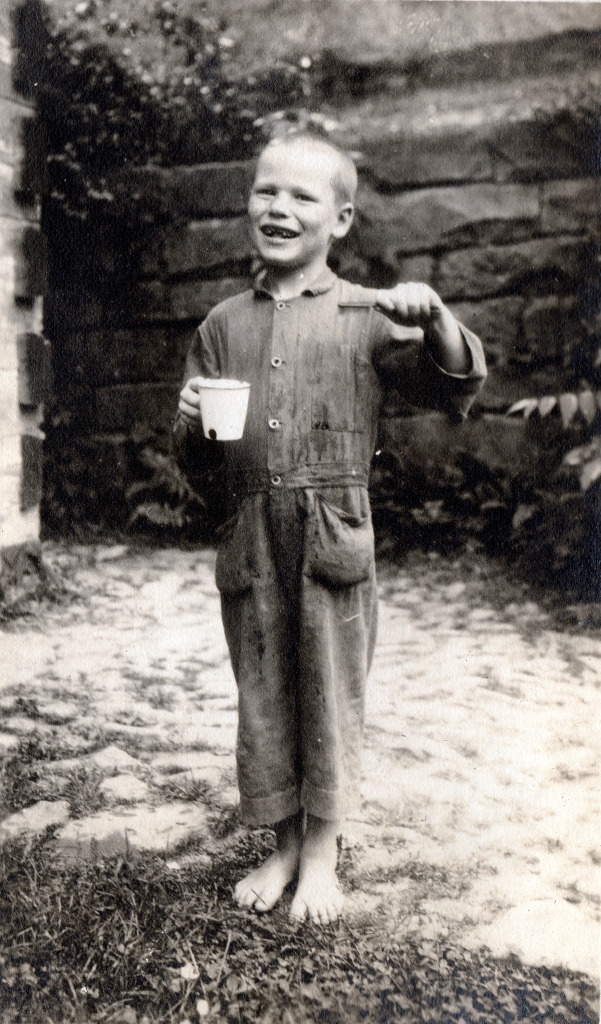
Maya Sudo Album: Small boy with cup and toothbrush, practicing “good dental hygiene.” 021c
We Are congratulating ourselves on the fact that Dr. Grant is so interested in the needs he has found here that he is adopted us, and proposes to come every year to hold a similar clinic.
Number of people examined, 135.
Number of teeth pulled, 140 for 60 people.
Number of teeth filled, 101 for 30 people.
Teeth cleaned for 5 people.
Receipts, $34.00.
*****
The letter printed below has just come in with a dollar enclosed. You will understand the pleasure with which we give it to you. it was an answer to the Christmas letter of 1917, from which we quote, the part needed for explanation:
” …. Some ten days before Christmas… . Santa Claus left at our gate a letter, full of kindly information about himself and his ways, for the 30 or 40 children who had never seen Christmas before. He not only laid stress on his well – known love of good behavior, but went into particulars writing: ” I won’t bring any candy to little boys or girls. Who leave their night gowns on the floor in the morning, or don’t open their beds, or keep their noses clean!” ‘
DEAR MISS DE LONG:
Mother read your letter for us at the dinner table.. I thought it was as interesting as a very good story. It made us feel both sad and happy. We laugh when we think of Santa Claus, who wants all the children to blow their noses. Many times I think I would rather go out and do the chores than to blow my nose. Father tells me so often.”Teddy, . blow your nose.” He must think I need to do it.
I know that the children must be very happy in their new home, with you for their foster mother. I have a good home and a father and mother that love me.. It would have been awful for those little children had you not taken care of them, Miss De Long. When mother was through reading your letter, she had tears in her eyes. my sisters and myself felt awful sad too.
Father gives me a cent for every cow I milk. (I milk two) and a cent for cleaning the barn. Last month I earned fifty-nine cents. I want to help the little ones and send a dollar. Perhaps I can send one dollar a year. I was going to send it to the bank But when I heard your letter I made up my mind to send it to those little children.
I must get ready for school. I am in the fifth grade and ten years old.
Your new friend,
Theodore Westergaard
Brooten, Minn., February 9, 1917.
*****
No children coming to Pine Mountain have gotten as much education from it as the Executive Committee. Five years ago, when we first decided that there must be a road across Pine Mountain, we thought it could be built in a few month’s time for something like $10,000 — a liberal sum in our view. Perhaps ignorance was a help in this case, for we might not have had the courage to attempt a road that would cost $10,000 a mile. Now, after four years spent in raising the money, getting the road surveyed, and technical details shaped up, the road is begun. Its construction is in the charge of a division engineer if the State Department of Roads, and the work is being done by convicts. It is considered to be the most difficult engineering problem that the State has ever had to meet. Some three-quarters of a mile are already graded. We shall always love the old trail, one mule wide and twenty-per-cnet-grade steep; but the new road passes under cliffs that the trail gave us no knowledge of, and reveals the wonderful rocky structure of Pine MountainMountain as well as its marvelous rhododendron thickets.
*****
We were unable to close our books and publish our usual financial statement early in the year because of the fire. We have now changed our fiscal year to end with the 30th of June. The financial statement, which Mildrum & Meldrum, of Louisville, our accounting firm, are preparing, will be issued either as a separate leaflet or printed in the next number of the NOTES.
*****
One of our workers, Miss Lilliath Robbins, who has been our primary teacher for two years, has been spending two months …..
P. 4
.….on Little Laurel, a tiny creek across the First Kentucky Ridge, some three miles away from the School. Miss Robbins knows this neighborhood intimately now. For she has had a Sunday school which has met in all sorts of weather for most of the two years. The suggestion. came, most naturally from one of the Fathers of a large family of children. That she should come over this summer and teach the school which had been closed for two years. One of the families on the creek had moved away, and there weren’t enough children left for the county to engage a teacher.
You must take the trip from the School, as we have been doing on our visits to Miss Robbins this summer, to understand how utterly shut away this district is. You must climb Steel Trap Branch to the end of the rough wagon trail, where our wagon had to unload lumber to repair the house and all of Miss Robbins’ household goods —-her double – decker. bedstead, pots and pans, and a folding table or so. You must look down through a cornfield, which even in this country has the reputation of being steep, to the homes nestled at the foot. You must slide and quote “scoot” down the ridge and think as you do so of the neighbors who packed their bedsteads and mattresses and kitchin kettles on their backs down the same path to Miss Robbins’s log house, which you will find tucked away under two chestnut trees a little farther up the creek. You must have supper out of doors watching the sunset light fade on the hills which gather so closely around you, and then see the moon come up, nearer than it has ever seemed before, while you hear all the news of the creek. One neighbour’s cows were lost for five days in the mountains, while the mother of the family was out looking for them, leaving her youngest child with its grandmother. This old lady has had 17 children, and says, “When they’re little, they’re on your feet, and when they’re big, they’re on your heart.” You must steep yourself in the atmosphere of the old log house where four families have lived. The last sound you hear as you drop off to sleep is that of a cowbell tinkling in an upland pasture; Your last sight is that of the Moonlight pouring through the screened openings in the log walls on to the chimney, chinked with mud., reaching just to the roof – tree.
The little place is chased in its spotlessness—- scrubbed punches, clean, new oil – cloth covering the boards, which have been knocked up for wash stands, boiling water to deal with the enamel ware dishes, and the dishcloth, which suns on the boughs of the chestnut tree while Miss Robbins is off at school. Up and down the footpath that follows the Creek, climbing through the forest where the “company” axe has not yet penetrated or skirting a cornfield whose upper border is the top of the ridge, there is a surprising amount of travel, and almost always a neighbor will drop in at breakfast time, sitting down with you, perhaps to take a cup of coffee, and losing not a single action of Miss Robbins’ housekeeping.
Down the creek a short distance is the schoolhouse, where the children are taking the greatest interest in the housekeeping they do there, all so new to them, “Why d’ you reckon we never thought of this before?” asked one boy as they cleaned up at the close of school, sweeping and dusting, cleaning the blackboards, disposing of the trash, and straightening the rude benches and desks. One day they had a magnifying glass to pass around, and one pupil, looking at a picture of the house fly through it, exclaimed, “Lord. ha’ mercy, it’s as big as a yearling !”
Two months’ schooling out of two years is only a beginning in acquiring an education, but it is a beginning we must be thankful for. Many of the 14 children have learned to read in the short two months, and all of them have gotten a sense of something outside the narrow confines of their own valley, And a year that is calendared by. the corn crop — ” planting time,”layin’ by,” and fodder – pulling.
EXECUTIVE COMMITTEE
Miss Katherine Pettit Mrs. Ethel de Long Zande
Treasurer, C.N. Manning, Security Trust Co. Lexington, Ky.
THE MARCHBANK PRESS
NEW YORK
Return to NOTES – INDEX

